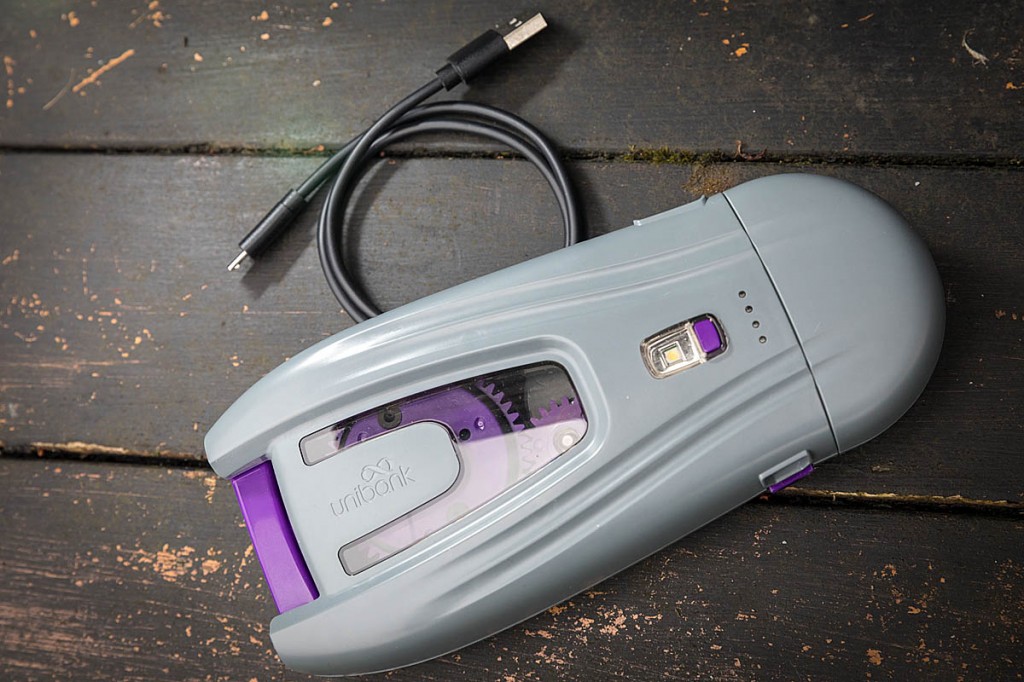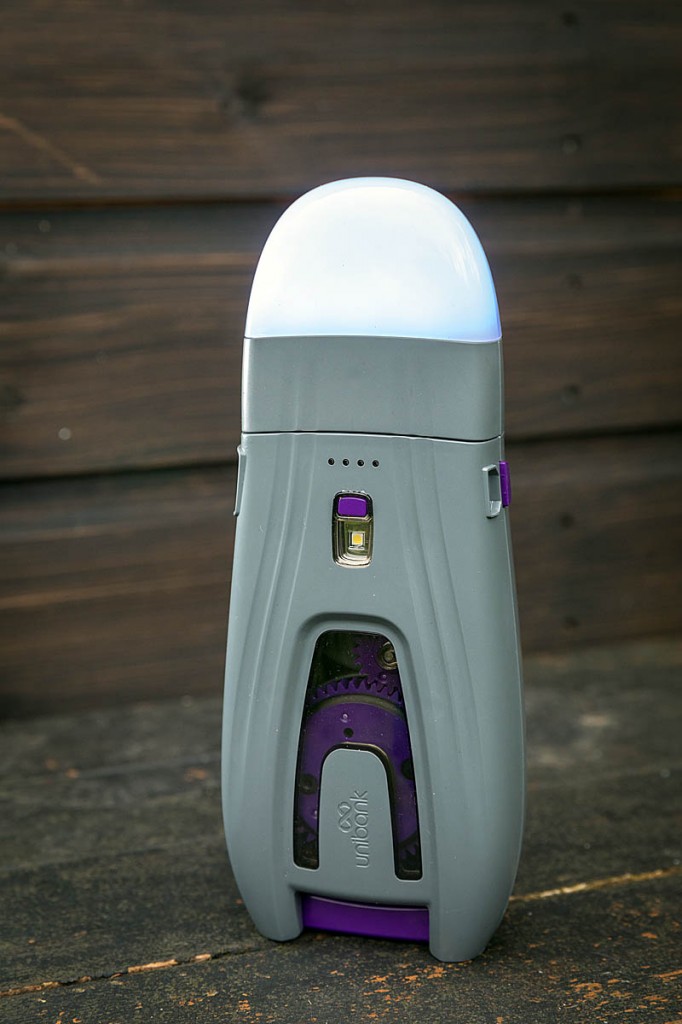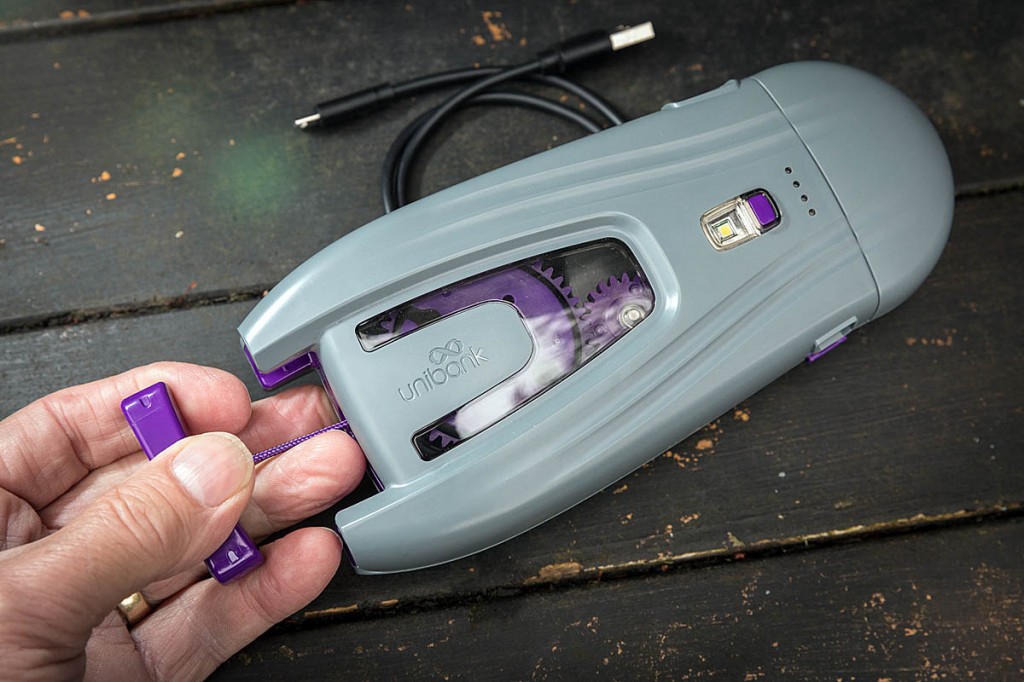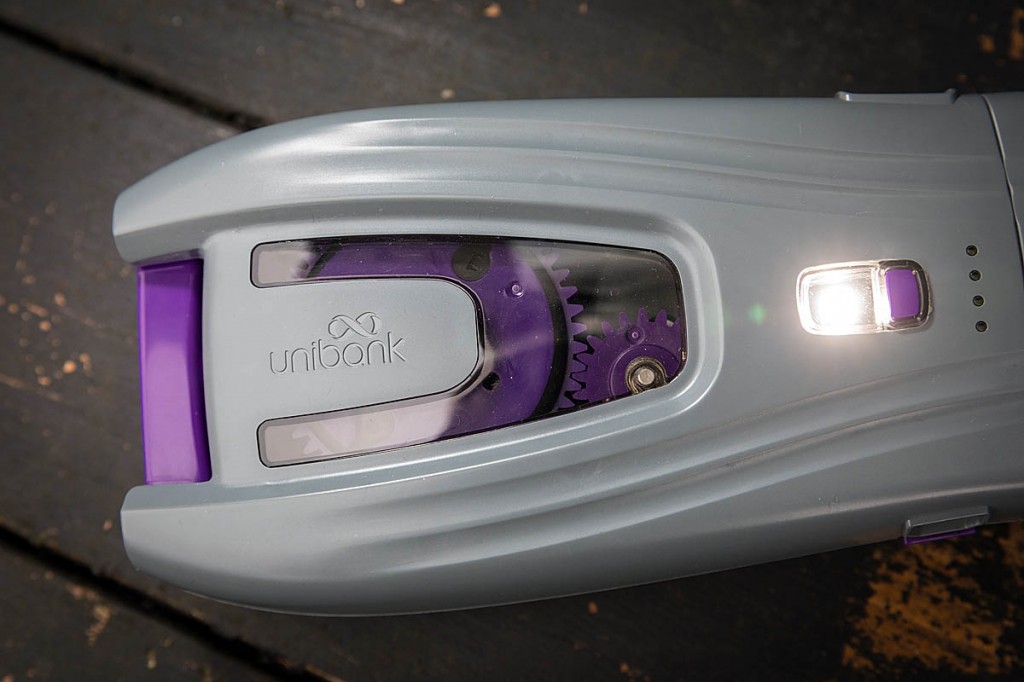Price: £89.95 (powerbank)
£24.95 ambient light accessory
461g with USB lead (481g with ambient light attached)
Battery capacity: 5,000mAh
Input: 5V 2A
Output: 5V 2a
Size: 18.2cm x 8.4cm x 4.5cm
Operating ambient temperature: -5C to 45C
Country of manufacture: Great Britain
The Unibank is an innovative powerbank that allows additional recharging of its internal 3.7V lithium-ion battery without plugging into an electricity source.
A pull cord is used to induce charge into the powerbank – using muscle power converted into electrical charge via a series of plastic toothed cogs, visible through a transparent window in its top cover.
As well as using the pull cord, the Unibank can be charged more conventionally, using the supplied micro USB lead. The unit has an input socket and an output socket. The lead can be plugged into the output socket and connected to the device you want to charge.
Anyone with an iPhone will, of course need to use a USB-to-Lightning lead, which isn’t supplied, to charge up their mobile. You will need a smartphone, either an iPhone or Android phone, to fully use the Unibank, including an accurate charge level and control of the optional add-ons.
Unibank also makes a range of accessories for the powerbank, which clip onto the end of the unit. A pair of release buttons allows the blank cap to be removed to reveal two plastic spigots and an electrical connector. Onto this can be attached the ambient light, a wireless speaker, a panic alarm or a laser measurer. A free app, available in both Android and iOS versions, allows control of these optional accessories. The app, which works via Bluetooth, also enables charge levels of both the Unibank battery and that of a device being charged, to be checked.
Unibank recommends you don’t charge the unit for more than 90 seconds using the pull cord. The sequence to be followed is: pull the cord for 30 seconds; rest 30 seconds; repeat the 30 seconds charge process; rest; complete one final charging cycle. When we did this with the unit’s battery at a pretty low level, it charged it to 12 per cent.
The manufacturers say this will provide 25 minutes talk time on a typical smartphone. So the manual pull cord charging can be treated as giving emergency power for a phone call.
The unit also has a button on its top side that, when pressed, gives an instant indication, via four LEDs, of the Unibank battery’s charge. Pressing the button twice turns on a small LED torch.
Charging of a phone wasn’t especially quick: it took the Unibank just under an hour to raise my iPhone charge from 94 per cent to 100 per cent, during which time the Unibank’s battery charge dropped from 12 per cent to four per cent.
The Unibank is a fairly chunky device and tips the scales at 461g, which makes it a bit of a beast for a backpacker to lug about, though it would be a boon when on a multi-day trip without access to mains electricity if it were smaller and less weighty.
At basecamp or in the family tent, it’s a useful addition to the camping gear bag. The addition of the £24.95 ambient light will provide up to 30 hours illumination with a fully charged Unibank. The colour of the light’s LED can be varied throughout the spectrum to suit the in-tent mood using the Unibank app. The unit can be stood upright on its flat base if you’re using the powerbank with its ambient light attachment.
The app is used to turn the light on and off and control its colours. As well as chosen steady lights, the ambient light can be set to flash in various colours or cycle through a range of colours.
A body clip and arm strap can be bought for £9.95, which allows the Unibank to be attached to a belt or worn on the arm. These are aimed more at users such as construction site workers rather than campers, though the clip could be useful if moving around the campsite.
Of less immediate interest to outdoor enthusiasts are a 120 dB panic alarm attachment, costing £24.95 and the £74.95 distance measurer, which also incorporates a laser line. The former, as well as emitting the loud alarm, will send an SOS message to chosen recipients, along with your GPS co-ordinates. This could be useful in an outdoors situation, though ringing 999 and asking for police – mountain rescue will probably get a faster response. You can also pay for a subscription to an emergency call service that bypasses 999 call centres. The main problem with the use of the Unibank as a panic alarm is its size and weight. It’s not of a size that slips easily into a handbag or pocket and, again, if you’re backpacking its bulk and weight will preclude its use by those conscious of minimising pack loads.
The distance measurer is clearly aimed at surveyors and builders. I can’t think of a situation in the outdoors where it would be of any use.
Another accessory that can be bought is a protective silicone sleeve, but unless you’re a particularly rough user of outdoor gear, that’s probably best left to those in the construction industry.
One niggle is that the unit disconnects its Bluetooth signal from your phone after a short time, and you have to press the control button on the Unibank to re-establish the connection to check charge status or control accessories such as the ambient light. At one point during testing, the Bluetooth function stopped completely and was only resumed by putting the unit into sleep mode by holding down the button until its LEDs flashed, and then restarting the Unibank. The company recommends that the unit be put into sleep mode anyway when not in use, to maintain its charge. This is achieved by pressing the unit’s button until the LEDs flash.
The Unibank unit and the ambient light supplied felt well made and quality is good.
The company is aiming the unit and its attachments at the camping and leisure sectors, plus travel and activities such as festivals. Obviously, the laser tool and measuring unit are designed with construction, estate agents and allied trades in mind. Unibank also sees a use for its product by lorry drivers, engineers and business travellers.
For the outdoors sector, for me its biggest drawback is its bulk and, particularly, its weight. It’s a very useful gadget for giving your mobile phone that boost when its battery is almost depleted, and we’ve also used it to recharge headtorches. With a growing number of electronic devices finding their way into walkers’, cyclists’ and climbers’ packs these days, the Unibank is undoubtedly a good item to have when you’re off grid. But for lightweight backpacking, wild camping or even climbs with a long walk-in, I found it just too big and heavy to pack into my rucksack.
At basecamps and during family camping holidays, however, it is ideal, especially when there aren’t mains outlets nearby to charge up your essential gadgetry. Enthusiasts such as anglers will probably find it useful too.
If Unibank could come up with a smaller and lighter unit, that could be a boon for trekkers and wild campers and anyone spending time ‘off grid’.
Versatility 21/30
Functionality 24/30
Ease of use 15/20
Quality 7/10
Value for money 6/10
Total 73/100
The unit and ambient light were supplied to grough by Unibank




JT
09 August 2021In truth the Unibank with its 5000 mAh battery is obsolete already. The battery on my phone has more capacity than that (M31 Samsung). For around £30 less you can buy an Anker powerbank with over five times the mAh of the Unibank, which is also lighter and far more practical for both family camps and backpacking trips.
Norman Noal
27 September 2023I Find it difficult to understand the diverse applications on this product and why any person purchasing would use them all.It seems to be a Jack of all trades and master of non.An expensive item that has already been made obsolete by more efficient chargers.